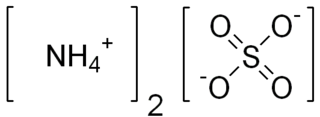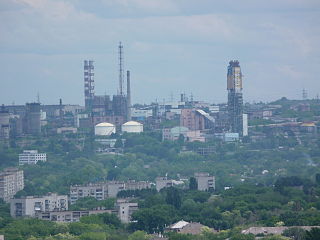
Ammonia is an inorganic compound of nitrogen and hydrogen with the formula NH3. A stable binary hydride, and the simplest pnictogen hydride, ammonia is a colourless gas with a distinct pungent smell. Biologically, it is a common nitrogenous waste, particularly among aquatic organisms, and it contributes significantly to the nutritional needs of terrestrial organisms by serving as a precursor to 45% of the world's food and fertilizers. Around 70% of ammonia is used to make fertilisers in various forms and composition, such as urea and diammonium phosphate. Ammonia in pure form is also applied directly into the soil.
Urea, also called carbamide, is an organic compound with chemical formula CO(NH2)2. This amide has two amino groups joined by a carbonyl functional group. It is thus the simplest amide of carbamic acid.

A fertilizer or fertiliser is any material of natural or synthetic origin that is applied to soil or to plant tissues to supply plant nutrients. Fertilizers may be distinct from liming materials or other non-nutrient soil amendments. Many sources of fertilizer exist, both natural and industrially produced. For most modern agricultural practices, fertilization focuses on three main macro nutrients: nitrogen (N), phosphorus (P), and potassium (K) with occasional addition of supplements like rock flour for micronutrients. Farmers apply these fertilizers in a variety of ways: through dry or pelletized or liquid application processes, using large agricultural equipment or hand-tool methods.

The ammonium cation is a positively charged polyatomic ion with the chemical formula NH+4 or [NH4]+. It is formed by the protonation of ammonia. Ammonium is also a general name for positively charged (protonated) substituted amines and quaternary ammonium cations, where one or more hydrogen atoms are replaced by organic or other groups.

Ammonium nitrate is a chemical compound with the chemical formula NH4NO3. It is a white crystalline salt consisting of ions of ammonium and nitrate. It is highly soluble in water and hygroscopic as a solid, although it does not form hydrates. It is predominantly used in agriculture as a high-nitrogen fertilizer.

Ammonium sulfate (American English and international scientific usage; ammonium sulphate in British English); (NH4)2SO4, is an inorganic salt with a number of commercial uses. The most common use is as a soil fertilizer. It contains 21% nitrogen and 24% sulfur.

Calcium nitrate, also called Norgessalpeter or Norwegian salpeter, is an inorganic compound with the formula Ca(NO3)2(H2O)x. The anhydrous compound, which is rarely encountered, absorbs moisture from the air to give the tetrahydrate. Both anhydrous and hydrated forms are colourless salts. Calcium nitrate is mainly used as a component in fertilizers, but it has other applications. Nitrocalcite is the name for a mineral which is a hydrated calcium nitrate that forms as an efflorescence where manure contacts concrete or limestone in a dry environment as in stables or caverns. A variety of double salts are known including calcium ammonium nitrate decahydrate (NH4NO3·5Ca(NO3)2·10H2O) and calcium potassium nitrate (Ca(NO3)2·4KNO3).
Metabolic wastes or excrements are substances left over from metabolic processes (such as cellular respiration) which cannot be used by the organism (they are surplus or toxic), and must therefore be excreted. This includes nitrogen compounds, water, CO2, phosphates, sulphates, etc. Animals treat these compounds as excretes. Plants have metabolic pathways which transforms some of them (primarily the oxygen compounds) into useful substances.

Mangalore Chemicals & Fertilizers Limited is the largest manufacturer of chemical fertilizers in the state of Karnataka, India. The company is part of the Adventz Group. The company's corporate and registered office is at UB City, Bangalore and its factory unit is in Panambur, north of Mangalore.

Sable Chemical Industries Limited is the sole manufacturer of ammonium nitrate (NH4NO3) in Zimbabwe.
Urea (46-0-0) accounts for more than fifty percent of the world's nitrogenous fertilizers. It is found in granular or prill form, which allows urea to be easily stored, transported and applied in agricultural settings. It is also the cheapest form of granular nitrogen fertilizer. Since urea is not an oxidizer at standard temperature and pressure, it is safer to handle and less of a security risk than other common nitrogen fertilizers, such as ammonium nitrate. However, if urea is applied to the soil surface, a meaningful fraction of applied fertilizer nitrogen may be lost to the atmosphere as ammonia gas; this only occurs under certain conditions.

TogliattiAzot is a Russian chemical company that has been described as the world's largest ammonia producer. It is headquartered in Tolyatti, Russia.
Ammoniacal nitrogen (NH3-N) is a measure for the amount of ammonia, a toxic pollutant often found in landfill leachate and in waste products, such as sewage, liquid manure and other liquid organic waste products. It can also be used as a measure of the health of water in natural bodies such as rivers or lakes, or in man made water reservoirs. The term is used widely in waste treatment and water purification systems.
EuroChem Group AG is a Swiss fertilizer producer. It is a fertilizer manufacturer with its own capacity in all three primary nutrients – nitrogen, phosphates and potash. It is headquartered in Zug, Switzerland.

Ammonium carbamate is a chemical compound with the formula [NH4][H2NCO2] consisting of ammonium cation NH+4 and carbamate anion NH2COO−. It is a white solid that is extremely soluble in water, less so in alcohol. Ammonium carbamate can be formed by the reaction of ammonia NH3 with carbon dioxide CO2, and will slowly decompose to those gases at ordinary temperatures and pressures. It is an intermediate in the industrial synthesis of urea (NH2)2CO, an important fertilizer.
Ostchem Holding is a holding company that unites a group of chemical factories and supporting companies. In its turn Ostchem is a part of bigger Group DF that unites several separate enterprises and other holding companies and is owned by Ukrainian oligarch Dmytro Firtash.
Uralchem Group is a Russian manufacturer of a wide range of chemical products, including mineral fertilizers and ammoniac saltpeter. It is the largest producer of ammonium nitrate as well as the second largest producer of ammonia and nitrogen fertilizers in Russia. The products are supplied in addition to Russia to the CIS countries, Eastern Europe, Asia, Africa and Latin America.
Nitrofert AS is a manufacturer of fertilizers based in Kohtla-Järve, Estonia. It is a subsidiary of Ostchem Holding, owned by Ukrainian oligarch Dmytro Firtash.

Sievierodonetsk Association "Azot" is chemical producer based in Sievierodonetsk, Luhansk Oblast, Ukraine. It is the third largest producer of ammonia in the country and one of the largest in Europe; producing nitrogen fertilizers, methanol, acetic acid, vinyl acetate, and their derivatives; acetylene, formalin, catalysts, household chemicals, and other chemical products. The successor of the Lysychansk Nitrogen Fertilizer Plant built in 1934, "Azot" produced its first output of ammonium nitrate on 1 January 1951. Sometime after the dissolution of the Soviet Union, the chemical plant was acquired by Ostchem Holding, part of Group DF run by Ukrainian oligarch Dmytro Firtash.

DniproAzot located in Kamianske, Dnipropetrovsk Oblast is an enterprise in the chemical industry of Ukraine. DniproAzot is a significant producer of ammonia, nitrogen fertilizers, urea, caustic soda, chlorine, and hydrochloric acid. DniproAzot is one of the five largest chemical enterprises in the country. In May 2018, the company celebrated its 80th anniversary.













